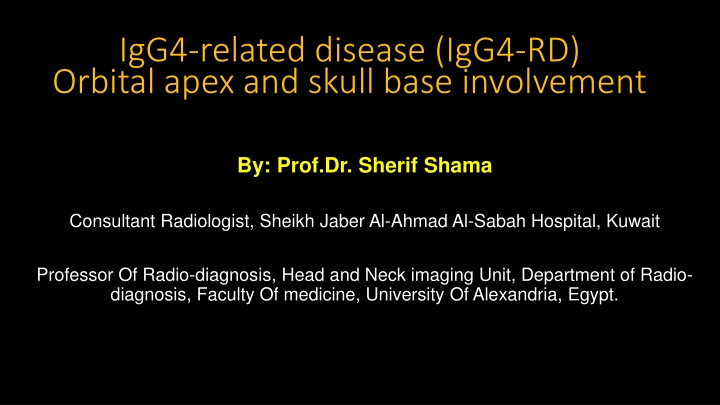
IgG4-Related Disease Involving Orbital Apex and Skull Base
Learn about a case of IgG4-related disease presenting with orbital apex and skull base involvement in a 58-year-old female. Find out about the clinical presentation, imaging findings on MRI, elevated serum IgG4 levels, and management with systemic glucocorticoids leading to clinical improvement.
Download Presentation

Please find below an Image/Link to download the presentation.
The content on the website is provided AS IS for your information and personal use only. It may not be sold, licensed, or shared on other websites without obtaining consent from the author. If you encounter any issues during the download, it is possible that the publisher has removed the file from their server.
You are allowed to download the files provided on this website for personal or commercial use, subject to the condition that they are used lawfully. All files are the property of their respective owners.
The content on the website is provided AS IS for your information and personal use only. It may not be sold, licensed, or shared on other websites without obtaining consent from the author.
E N D
Presentation Transcript
IgG4-related disease (IgG4-RD) Orbital apex and skull base involvement By: Prof.Dr. Sherif Shama Consultant Radiologist, Sheikh Jaber Al-Ahmad Al-Sabah Hospital, Kuwait Professor Of Radio-diagnosis, Head and Neck imaging Unit, Department of Radio- diagnosis, Faculty Of medicine, University Of Alexandria, Egypt.
58 years female patient presented with gradual long-standing left sided propotosis with visual disturbance and trigeminal neuralgia -Her MRI revealed markedly enhancing space occupying lesion targeting the left orbital apex surrounding the optic nerve. -The lesion showed T2 low signal. -Extension into the left Meckel s cave and left cavernous sinus. -Peri-neural spread along mandibular division of the trigeminal nerve (V3) reaching the masticator space. -Extension to the left pterygo-palatine fossa and along the left infra-orbital nerve. -The extra-ocular muscles were thickened and hyper-enhancing . -Serum IgG4 level was elevated (>135 mg/dL). -Due to high risk biopsy, systemic glucocorticoids were started and the patient improved clinically and on follow-up laboratory and radiological investigations.
B A C -Markedly enhancing SOL targeting the left orbital apex, surrounding the optic nerve (arrow in A, axial T1 fat sat +C). D -The lesion is showing T2 low signal (arrow in B, axial T2 WI) -It is reaching the left pterygo-palatine fossa (arrow in C, axial T1 fat sat +C). -The extra-ocular muscles are thickened and hyper- enhancing (arrow in D axial T1 fat sat +C).
E F G The lesion is implicating the left Meckel s cave ( arrow in E, Coronal T2WI). -Peri-neural Extension along the left V3 down to masticator space (arrow in F, coronal T1 fat sat +C). G, coronal T1 fat sat +C showed hyper-enhancement of the extra-ocular muscle and enhancing left infra-orbital nerve (arrow).
References Horger M, Lamprecht HG, Bares R, et al. Systemic IgG4-Related Sclerosing Disease: Spectrum of Imaging Findings and Differential Diagnosis. American Journal of Roentgenology. 2012;199(3):W276-W282. doi:https://doi.org/10.2214/ajr.11.8321. Kamisawa T, Okamoto A. IgG4-related sclerosing disease. World Journal of Gastroenterology. 2008;14(25):3948. doi:https://doi.org/10.3748/wjg.14.3948. Weerakkody Y, Jones J, Schultz K, et al. IgG4-related disease. Reference article, Radiopaedia.org (Accessed on 04 Jan 2025) https://doi.org/10.53347/rID-17290 Koch BL, Surjith Vattoth, Chapman PR. Diagnostic Imaging: Head and Neck - E-Book. Elsevier Health Sciences; 2021.
